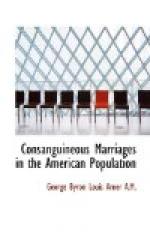[Footnote 74: Shattuck Memorials, p. 118.]
CHAPTER VI
CONSANGUINITY AND THE SPECIAL SENSES
The most important source for this chapter is the special report on the Blind and the Deaf in the Twelfth Census of the United States.[75] This report was prepared under the direction of Dr. Alexander Graham Bell, as Expert Special Agent of the Census Office.
[Footnote 75: U.S. Census, 1900, Special Report on the Blind and the Deaf.]
The enumerators of the Twelfth Census reported a total of 101,123 persons as blind, and to each of these Dr. Bell addressed a circular of inquiry. By this method he obtained verified returns of 64,763 cases of blindness in continental United States or 85.2 per 100,000 of the total population. In the same way he obtained data in regard to 89,287 persons with seriously impaired powers of hearing, or 117.5 Per 100,000 of the total population.
In each case the following questions among others were asked: “Were his (or her) parents first cousins? If not first cousins were they otherwise related by blood to each other, before their marriage? Were any of his relatives blind? If yes, what relatives? (Father, mother, grandparents, brothers, sisters, uncles, aunts, and how many of each, so far as known).” The results of this inquiry give us the best and most reliable statistical material which has ever been compiled on any phase of the problem of consanguineous marriage. The investigation of the deaf was similar to that of the blind, but even more complete.
I. The Blind. The question as to the relationship of the parents was answered in 56,507 cases, in 2,527 or 4.47 per cent of which the parents were reported as cousins. Of the 57,726 who answered the question in regard to blind relatives, 10,967 or 19 per cent replied in the affirmative.[76] The blind relatives were divided into two groups: (a) blind brothers, sisters or ancestors, and (b) blind collateral relatives or descendants. Table XXII concisely expresses the results most fundamental for this study.
[Footnote 76: U.S. Census, 1900, op. cit., p. 16.]
TABLE XXII. ------------------------------------------------------------
----- | |Having |Having | | | |Blind |blind | | | |relatives|relatives|Having | Consanguinity of | |Class |Class |no blind | Not Parents. |Totals|(a).[A] |(b).[A] |relatives|Stated. ------------------------------------------------------------
----- The blind |64,763| 8,629 | 2,338 | 46,759 | 7,037 ------------------------------------------------------------
----- Totally blind |35,645| 4,378 | 1,215 | 26,349 | 3,703 Partially blind |29,118| 4,251 | 1,123 | 20,410 | 3,334 | | | | | Parents cousins. | | | | | —The blind | 2,527| 844 | 149 | 1,456 | 78




